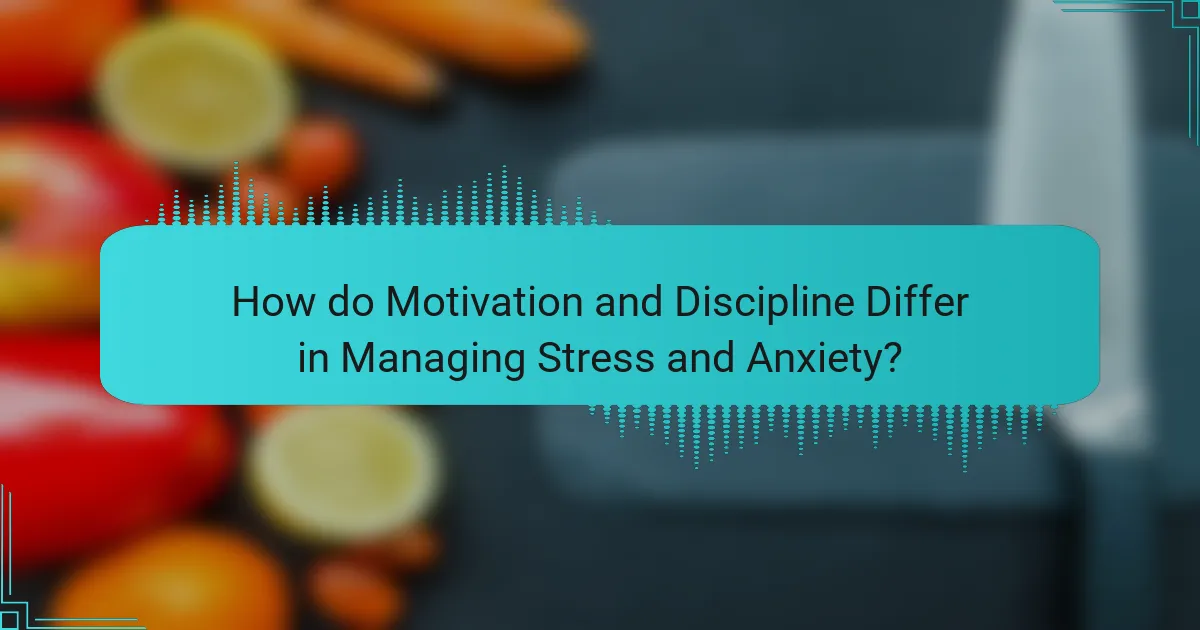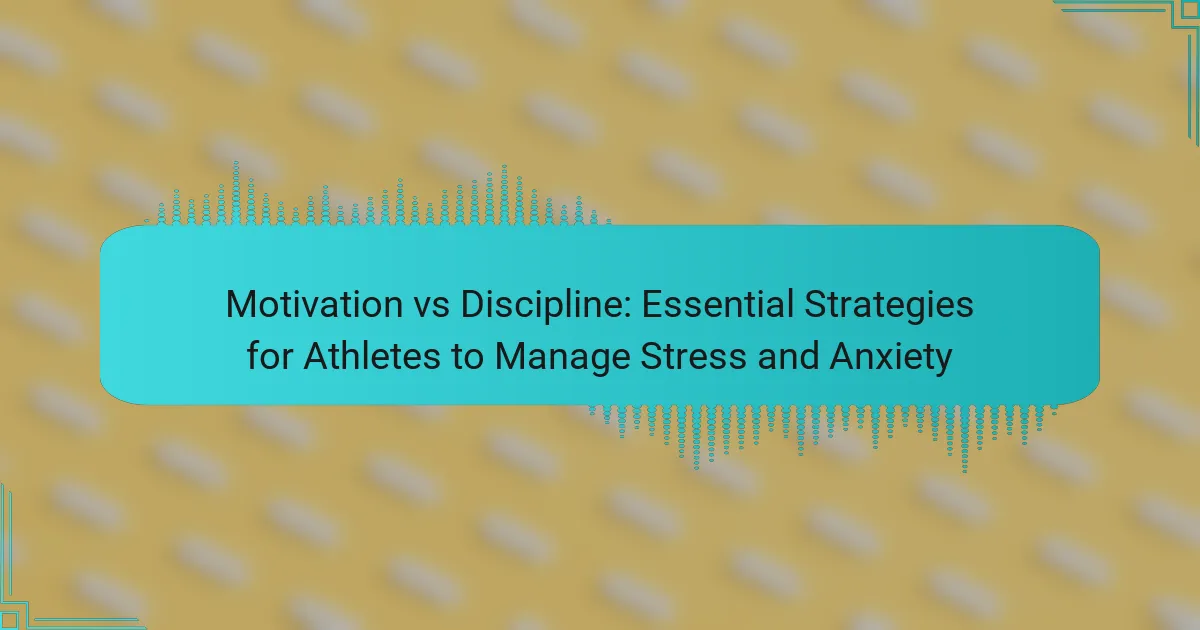Athletes often face stress and anxiety that can hinder performance. Understanding the balance between motivation and discipline is crucial for effective stress management. This article explores how motivation initiates engagement, while discipline sustains consistent practices. It also highlights goal-setting, mindfulness techniques, and the importance of a supportive network in enhancing resilience.

How do Motivation and Discipline Differ in Managing Stress and Anxiety?
Motivation drives athletes to take action, while discipline ensures consistent effort. Motivation can be fleeting, influenced by emotions or external factors, whereas discipline is a stable trait that fosters routine. For athletes managing stress and anxiety, motivation may spark initial engagement in stress-relief techniques, but discipline sustains long-term practices like regular training or mindfulness. Developing discipline creates resilience against stress, enabling athletes to perform under pressure. In contrast, relying solely on motivation may lead to inconsistency, increasing anxiety levels.
What Role Does Motivation Play in Athletic Performance?
Motivation significantly enhances athletic performance by driving commitment and focus. It influences goal setting, resilience, and the ability to manage stress and anxiety. Athletes with high motivation often demonstrate better training adherence and competitive outcomes. For example, intrinsic motivation fosters a love for the sport, leading to consistent practice and improved skills. Conversely, discipline complements motivation by ensuring athletes maintain their training regimen, even when motivation wanes. Understanding the interplay between these factors can help athletes optimize their performance strategies.
How Does Discipline Contribute to Coping Mechanisms?
Discipline significantly enhances coping mechanisms by fostering resilience and focus. Athletes who practice discipline develop a structured approach to stress management, enabling them to respond effectively to anxiety. This consistency in training and mindset cultivates mental fortitude, allowing athletes to maintain performance under pressure. Research indicates that disciplined routines lead to improved emotional regulation, which is crucial for coping during high-stress situations.

What Are the Universal Strategies for Athletes to Manage Stress?
Athletes can manage stress effectively through a balance of motivation and discipline. Motivation drives the desire to achieve goals, while discipline ensures consistent effort. Both elements are crucial for coping with stress and anxiety.
Setting clear, achievable goals enhances motivation, providing a roadmap for progress. Regular practice and routines foster discipline, creating a sense of control over training and performance. Mindfulness techniques, such as meditation, can reduce anxiety and improve focus, complementing both motivation and discipline.
Building a support network of coaches and peers offers emotional backing, which is vital for managing stress. Engaging in positive self-talk reinforces motivation and helps athletes maintain a disciplined approach during challenging times.
Incorporating rest and recovery into training schedules is essential for mental health. Athletes should prioritize sleep and relaxation to recharge physically and mentally, ultimately enhancing performance and stress management.
Which Techniques Enhance Mental Resilience?
Motivation and discipline are key techniques to enhance mental resilience in athletes. Motivation drives the desire to pursue goals, while discipline ensures consistent effort. Together, they help manage stress and anxiety effectively.
1. Set clear, achievable goals to maintain motivation.
2. Develop a routine to strengthen discipline.
3. Practice mindfulness to enhance focus and reduce anxiety.
4. Seek social support for encouragement and accountability.
5. Embrace challenges to build resilience over time.
How Can Athletes Use Goal Setting to Reduce Anxiety?
Athletes can use goal setting to reduce anxiety by creating clear, achievable objectives. This process enhances focus and provides a sense of control. Specific goals break down larger tasks, making them less overwhelming. Research shows that goal-setting can improve performance and decrease stress levels. Additionally, setting both short-term and long-term goals fosters motivation and discipline, essential for managing anxiety effectively.
What Are SMART Goals and How Do They Help?
SMART goals are specific, measurable, achievable, relevant, and time-bound objectives that enhance motivation and discipline in athletes. They provide clarity, focus, and a structured approach to managing stress and anxiety. By setting SMART goals, athletes can track their progress, maintain motivation, and adapt their strategies effectively, leading to improved performance and mental resilience. This structured method fosters a sense of accomplishment and reduces overwhelm, ultimately contributing to better stress management.

What Unique Approaches Can Athletes Adopt for Stress Management?
Athletes can adopt unique approaches for stress management by integrating mindfulness techniques and structured routines. Mindfulness practices, such as meditation and breathing exercises, enhance focus and reduce anxiety. Additionally, establishing a consistent daily routine cultivates discipline, which can counteract stress by providing structure. These strategies empower athletes to navigate competitive pressures effectively.
How Do Visualization Techniques Impact Performance?
Visualization techniques significantly enhance athletic performance by improving focus, reducing anxiety, and boosting motivation. These mental strategies enable athletes to create mental images of success, which can lead to increased confidence and better execution of skills. Research shows that athletes who regularly practice visualization report lower stress levels and improved coping mechanisms during competitions. By integrating visualization into their training routines, athletes can develop a unique mental framework that supports discipline and resilience in high-pressure situations.
What Is the Importance of Routine in Reducing Anxiety?
Routine is crucial for reducing anxiety as it creates a sense of predictability and control. Establishing a consistent schedule helps athletes manage stress by providing structure in their daily lives. This predictability allows for better focus on training and performance, ultimately enhancing mental resilience. Research shows that routines can lower cortisol levels, a key stress hormone, promoting a calmer state of mind. Incorporating mindfulness practices within a routine further supports emotional regulation, making it easier for athletes to cope with anxiety.

What Rare Strategies Have Proven Effective for Elite Athletes?
Elite athletes often utilize rare strategies that blend motivation and discipline to effectively manage stress and anxiety. These strategies include mindfulness techniques, visualization practices, and tailored goal-setting. Mindfulness helps in maintaining focus, while visualization aids in mental preparation for competition. Tailored goal-setting, which aligns personal values with performance objectives, fosters intrinsic motivation. These approaches not only reduce anxiety but also enhance overall performance by creating a resilient mindset.
How Can Mindfulness Practices Be Tailored for Competitive Sports?
Mindfulness practices can be tailored for competitive sports by integrating techniques that enhance motivation and discipline. These practices help athletes manage stress and anxiety effectively.
Athletes can implement focused breathing exercises before competitions to calm nerves and improve concentration. Visualization techniques can also be employed, allowing athletes to mentally rehearse their performance, which boosts confidence and reduces anxiety.
Incorporating mindfulness into training routines fosters a deeper connection to the present moment, enhancing performance. Regular practice can lead to improved emotional regulation, allowing athletes to respond better to competitive pressures.
Additionally, setting specific mindfulness goals can enhance motivation and discipline. Athletes can track their progress, reinforcing positive habits that contribute to their overall mental resilience in competitive environments.
What Innovative Stress-Relief Methods Are Emerging in Sports?
Innovative stress-relief methods in sports focus on mental resilience and emotional regulation. Techniques such as mindfulness meditation, biofeedback, and virtual reality therapy are gaining traction. These methods enhance athletes’ motivation and discipline, helping them manage stress and anxiety effectively. Mindfulness meditation improves focus and reduces anxiety, while biofeedback provides real-time data to help athletes control physiological responses. Virtual reality therapy simulates competitive environments, allowing athletes to practice stress management in a controlled setting. These approaches are reshaping how athletes cope with pressure, emphasizing mental health alongside physical training.

How Can Athletes Balance Motivation and Discipline for Optimal Performance?
Athletes can balance motivation and discipline by setting clear goals and maintaining consistent routines. Motivation drives engagement, while discipline ensures adherence to training regimens. Effective strategies include developing a supportive environment, using visualization techniques, and incorporating recovery practices. These elements help manage stress and anxiety, enhancing overall performance.
What Are Common Mistakes Athletes Make in Stress Management?
Athletes often make mistakes in stress management by neglecting discipline in favor of motivation. They may rely too heavily on fleeting inspiration rather than establishing consistent routines. Another common error is underestimating the importance of recovery, leading to burnout. Additionally, athletes frequently fail to set realistic goals, which can create unnecessary pressure. Lastly, poor communication with coaches and teammates can exacerbate stress levels, hindering performance.
What Best Practices Should Athletes Implement for Lasting Results?
Athletes should prioritize discipline over motivation for lasting results. Discipline fosters consistent training, while motivation can fluctuate. Establishing structured routines and setting realistic goals enhances focus, reducing stress and anxiety. Incorporating mindfulness practices, such as meditation, can also improve mental resilience. Regularly assessing progress and adapting strategies ensures athletes remain committed to their objectives.
How to Create a Personal Stress Management Plan?
Creating a personal stress management plan involves identifying stressors, setting clear goals, and implementing strategies. Start by recognizing triggers and their impact on performance. Next, establish specific, measurable objectives to reduce stress. Incorporate techniques like mindfulness, time management, and physical activity. Regularly review and adjust the plan based on effectiveness and changing circumstances. This approach fosters resilience and enhances overall well-being for athletes.


